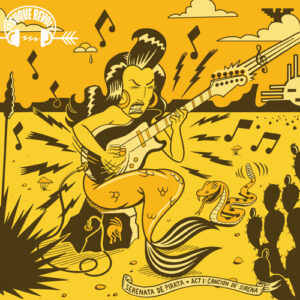Here is an album by a septet of players who collectively call themselves SubTractor. After to listening to their album for a just about a minute—the first go-around, ya know— I realized they’ve got that Muscle Shoals Sound Studio thing going on. By which I mean that, as the horns flared and the organ blared coming right out of my speaker like a loud proud and perfectly beautiful but not flowery thing, I got it that this group of musicians (trumpet player Eric Coker, trombonist and vocalist Brian Evans, saxophonist Brent Kelly, guitarist Richard Kilmer, bassist and vocalist Jens Langsjoen, drummer Luke Phillips and organist Dan Waldman) sure can play their way around the complex genre popularized by outifts like The Band, Chicago and the Tower of Power. It’s damn hard to rock out to this particular type of American music, but these fellows do a great job of jamming. Tracks like “Mercury’s Oddysey” have a jazz touch that would have Walter Becker blushing, could he hear its majesty from the strat-shaped clouds that buoy his flight through eternity. “Detroit Twice” is a dark and driving funky groove wound up in a musical description of a city perfectly understood by Coker’s horn and Kelly’s sax. This album should be required listening for two reasons: Number one, it’s like straight outta Burque. Number two: It’s totally arch.
Tesuque Revolt Serenata de Pirata (Self-Released)
Due to drop in October of the year 2018, the first official recording by desert-dancing sound seers Tesuque Revolt has but four musical events within this puro maximalist collection of tunes and corollary imagery. Check out the cover, ese, where a Zia-themed sun sets while a mermaid and rattlesnake make musical communion against a backdrop of mesas and various succulents. There’s a thunderbird in there too, lurking somewhere near the puffy clouds. Much like the visual representation presented to listeners who seek out this fantastic recording, the music comes from many directions and traditions at once. Latin rhythms, R&B inflected vocals for the English songs, electronic instrumentation galore, some guitar-soaked rocanrol and a post-border pop aesthetic that suggests au currant pop sounds like those made by other LA bands from Chicano Batman to Mini Mansions land this record precisely within in the psycho-geographic boundaries one expects: This is the new music of the West. By track two, “3 Palomas,” a relentless dance beat is introduced in combination with the Spanish-speaking rap listeners have been craving since the opening track wound out, locating the music in space and time for even casual listeners. Overall, the eclectic approach to style and instrumentation seems natural here. Who would have guessed that, 20 years after Hello Nasty, the term “intergalactic” could stand for the good such experimental, cross-genre work legitimized.



